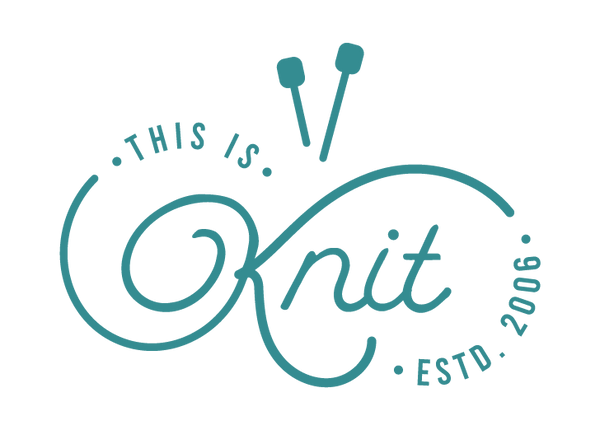Ingenious i-cord
January 30 2013 – thisisknit
 I-cord is one of the handiest things you can learn to make, but to judge from the questions that we're asked, a lot of people think it's hard. It's not. In fact, it's just a trick, and what's more, it's a very easy one.
You need either a circular needle or two double-pointed needles. (There's information at the bottom of this post about using single-points, but the other options are much, much easier.)
The first thing is to cast on four stitches. Four is a good number, though you may see three or five.
I-cord is one of the handiest things you can learn to make, but to judge from the questions that we're asked, a lot of people think it's hard. It's not. In fact, it's just a trick, and what's more, it's a very easy one.
You need either a circular needle or two double-pointed needles. (There's information at the bottom of this post about using single-points, but the other options are much, much easier.)
The first thing is to cast on four stitches. Four is a good number, though you may see three or five.
 Knit across your four stitches once.
Knit across your four stitches once.
 At the end of that first row, you'll have the working yarn at the left hand side of the work, coming out of the leftmost stitch. Don't turn the work!
At the end of that first row, you'll have the working yarn at the left hand side of the work, coming out of the leftmost stitch. Don't turn the work!
 Without turning the work, hoosh the stitches back to the right, all the way down to the other end of the needle.
Without turning the work, hoosh the stitches back to the right, all the way down to the other end of the needle.
 You still have the yarn coming out of the leftmost stitch on the needle. This is entirely right and proper, though it may feel a bit odd the first time.
You still have the yarn coming out of the leftmost stitch on the needle. This is entirely right and proper, though it may feel a bit odd the first time.
 With the yarn still coming of the leftmost stitch and without turning the work, knit the first stitch on the needle in your left hand (this is the rightmost stitch of the four). The yarn will be pulled across the back from the leftmost stitch to the rightmost, and that's what's supposed to happen.
With the yarn still coming of the leftmost stitch and without turning the work, knit the first stitch on the needle in your left hand (this is the rightmost stitch of the four). The yarn will be pulled across the back from the leftmost stitch to the rightmost, and that's what's supposed to happen.
 Repeat these steps: knit a row, don't turn, hoosh the stitches rightwards, knit a row, over and over again. At the beginning, it will look a bit flat and peculiar, but give it an inch or so...
Repeat these steps: knit a row, don't turn, hoosh the stitches rightwards, knit a row, over and over again. At the beginning, it will look a bit flat and peculiar, but give it an inch or so...
 It's not impossible to make icord with single-pointed needles, but it's a wee bit fiddlier. You need to slip the stitches back to the needle in your left hand without turning each time. Hooshing is much quicker, so even if you don't use double-points or circulars much, it's worth investing in some for icord.
Four is an optimal number to cast on - above that, the distance across the back of the work is a little too far and you risk getting a ladder up the back. But this has a use too. If you're making gloves, you can work the fingers as i-cord, working one stitch fewer in the round than instructed by the pattern. You'll get a substantial ladder at the back, but you can then use a crochet hook to take the bottommost rung and work it up through the rungs above as if you were working up a dropped stitch.
You can work i-cord as part of a cast on or a cast off, and you can apply it to the edges of a piece of knitting after the fact. We'll talk about these techniques in the future, but they're really just variations on this basic theme.
In taking the pictures for this post (and a number of others that are coming up), we were greatly helped by Niamh, who came to This Is Knit on work experience a couple of weeks ago. She's very talented not only at knitting but at all sorts of other creative pursuits as well, as you'll see from her blog at bluesewncat - there's so much that's interesting and delightful over there. Thank you, Niamh, and stay in touch!
It's not impossible to make icord with single-pointed needles, but it's a wee bit fiddlier. You need to slip the stitches back to the needle in your left hand without turning each time. Hooshing is much quicker, so even if you don't use double-points or circulars much, it's worth investing in some for icord.
Four is an optimal number to cast on - above that, the distance across the back of the work is a little too far and you risk getting a ladder up the back. But this has a use too. If you're making gloves, you can work the fingers as i-cord, working one stitch fewer in the round than instructed by the pattern. You'll get a substantial ladder at the back, but you can then use a crochet hook to take the bottommost rung and work it up through the rungs above as if you were working up a dropped stitch.
You can work i-cord as part of a cast on or a cast off, and you can apply it to the edges of a piece of knitting after the fact. We'll talk about these techniques in the future, but they're really just variations on this basic theme.
In taking the pictures for this post (and a number of others that are coming up), we were greatly helped by Niamh, who came to This Is Knit on work experience a couple of weeks ago. She's very talented not only at knitting but at all sorts of other creative pursuits as well, as you'll see from her blog at bluesewncat - there's so much that's interesting and delightful over there. Thank you, Niamh, and stay in touch!


3 comments
Hi
Could I ask do you sell i-cord? If not, do you know if anyone in Ireland does? I would prefer to.use an Irish supplier. I am based in Dublin.
Many Thanks
Theresa
[…] to knit these when I did work experience in this is knit,  (I also got a mention on their blog) I was working with this lady (her makes are stunning, seriously check it out, even more […]
That is a good blog post because I now realise I can make Icord with any one of the circulars that I own. I had a fixed idea that I needed DPNs (which I don’t own). I laughed the first time I read about Icord when I saw that it stood for Idiot Cord. Looking forward to seeing how to use it for cast on and edgings, it looks good used like that.